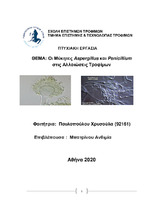| dc.contributor.advisor | Batrinou, Anthimia | |
| dc.contributor.author | Παυλοπούλου, Χρυσούλα | |
| dc.date.accessioned | 2021-03-02T06:35:31Z | |
| dc.date.available | 2021-03-02T06:35:31Z | |
| dc.date.issued | 2021-02-25 | |
| dc.identifier.uri | https://polynoe.lib.uniwa.gr/xmlui/handle/11400/252 | |
| dc.identifier.uri | http://dx.doi.org/10.26265/polynoe-103 | |
| dc.description.abstract | Στην παρούσα πτυχιακή περιγράφεται η συμβολή των μυκήτων στις αλλοιώσεις των τροφίμων. Το φάσμα των μυκήτων είναι πάρα πολύ μεγάλο κι έτσι περιγράφεται η δράση δύο από τους πιο διαδεδομένους μύκητες Aspergillus και Penicillium.
Στο πρώτο κεφάλαιο περιγράφεται ο μύκητας του γένους Aspergillus με τα πιο ενδιαφέροντα είδη που απασχολούν την Τεχνολογία των Τροφίμων, τα οποία είναι :
Aspergillus niger
Aspergillus oryzae
Aspergillus flavus
Aspergillus parasiticus
Aspergillus glaucus και repens
Στο δεύτερο κεφάλαιο περιγράφεται ο μύκητας του γένους Penicillium με τα πιο ενδιαφέροντα είδη που απασχολούν την Τεχνολογία των Τροφίμων, τα οποία είναι:
Penicillium italicum
Penicillium notatum και chrysogenum
Penicillium roqueforti
Penicillium camemberti
Penicillium expansum
Περιγράφονται τα χαρακτηριστικά τους, όσον αφορά, τη μορφολογία τους, την φυσιολογία τους (ανθεκτικότητα σε pH, aw, θερμοκρασία),την παρουσία τους στα τρό-φιμα και την δράση τους σε αυτά, επίσης και την παραγωγή μυκοτοξινών από κάποια είδη.
Στο τρίτο κεφάλαιο περιγράφονται οι κυριότερες μυκοτοξίνες που παράγονται από τους μύκητες Aspergillus και Penicillium. Αναφέρεται σε ποια τρόφιμα αναπτύσσο-νται οι μύκητες που παράγουν μυκοτοξίνες, οι οποίες είναι υπεύθυνες για καρκίνους, καθώς και για πολλές διαφορετικές διαταραχές που επηρεάζουν το γαστρεντερικό, ου-ρογεννητικό, αγγειακό, νεφρό και νευρικό σύστημα. Ορισμένες μυκοτοξίνες είναι ανοσο-κατασταλτικές, μειώνοντας έτσι την αντίσταση σε μολυσματικές ασθένειες. | el |
| dc.format.extent | 57 | el |
| dc.language.iso | el | el |
| dc.publisher | Πανεπιστήμιο Δυτικής Αττικής | el |
| dc.rights | Αναφορά Δημιουργού - Μη Εμπορική Χρήση - Παρόμοια Διανομή 4.0 Διεθνές | * |
| dc.rights.uri | https://creativecommons.org/licenses/by-nc-sa/4.0/deed.el | * |
| dc.subject | Aspergillus | el |
| dc.subject | Penicillium | el |
| dc.subject | Μύκητες | el |
| dc.subject | Αλλοιώσεις τροφίμων | el |
| dc.subject | Μυκοτοξίνες | el |
| dc.title | Οι Μύκητες Aspergillus και Penicillium στις Αλλοιώσεις Τροφίμων | el |
| dc.title.alternative | The fungi Aspergillus and Penicillium in food spoilage | el |
| dc.type | Πτυχιακή εργασία | el |
| dc.contributor.committee | Στρατή, Ειρήνη | |
| dc.contributor.committee | Κοντελές, Σπυρίδων | |
| dc.contributor.faculty | Σχολή Επιστημών Τροφίμων | el |
| dc.contributor.department | Τμήμα Επιστήμης και Τεχνολογίας Τροφίμων | el |
| dc.description.abstracttranslated | This thesis describes the contribution of fungi to food spoilage. The range of fungi is very large and thus describes the action of two of the most common fungi Aspergillus and Penicillium.
The first chapter describes the fungus of the genus Aspergillus with the most in-teresting species that deal with Food Technology, which are:
Aspergillus niger
Aspergillus oryzae
Aspergillus flavus
Aspergillus parasiticus
Aspergillus glaucus και repens
The second chapter describes the fungus of the genus Penicillium with the most in-teresting species that deal with Food Technology, which are:
Penicillium italicum
Penicillium notatum και chrysogenum
Penicillium roqueforti
Penicillium camemberti
Penicillium expansum
Their characteristics are described in terms of their morphology, their physiology (resistance to pH, aw, temperature), their presence in food and their action on them, as well as the production of mycotoxins by some species.
Chapter 3 describes the main mycotoxins produced by the fungi Aspergillus and Penicillium. It refers to the foods in which the fungi that produce mycotoxins, which are responsible for cancer, grow, as well as many different disorders that affect the gastroin-testinal, urogenital, vascular, renal and nervous systems. Some mycotoxins are immuno-suppressive, thus reducing resistance to infectious diseases. | el |


